Warwick tops online MBA ranking for fifth successive year
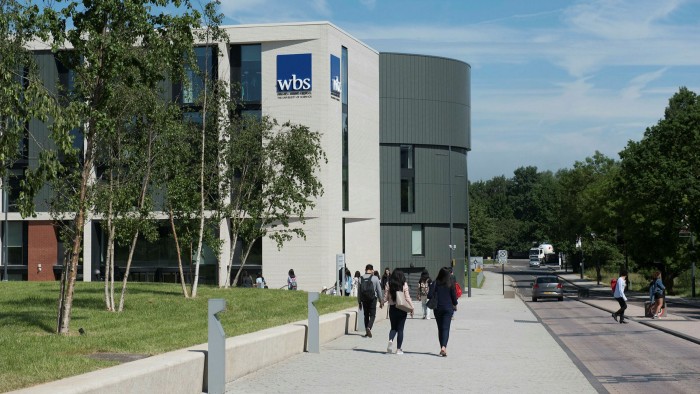
Roula Khalaf, Editor of the FT, selects her favourite stories in this weekly newsletter.
For the fifth consecutive year, Warwick Business School is number one in the Financial Times ranking of online MBAs. Alumni salary is again the main factor in Warwick’s success: an average of $194,864 three years after completion — a 36 per cent increase over that period.
Graduates praised Warwick’s online platform and programme materials, its careers service, and the support available to develop start-ups. One alumnus surveyed for the ranking said the course “served as a career accelerator, arming me with tools that [have] spurred me on to remarkable career success”.
Imperial College Business School, in second place, has the second-highest average salary at $192,016. But it comes first for international mobility — maintaining last year’s position — and for career progress, based on its alumni’s job seniority and the size of the organisations they now work, for compared with three years ago.
Spain’s IE Business school comes in third. It has the highest percentage of international students at 92 per cent, and ranks top in the environmental, social and governance category, as it has since 2019. Overall satisfaction with the school’s programme also improved, from 8.51 out of 10 in 2021, to 9.23.
FT Online MBA ranking 2022 — 10 of the best

Find out which schools are in our ranking of Online MBA degrees. Learn how the table was compiled below (methodology). Also, read the rest of our coverage at www.ft.com/online-learning.
In fifth position, University of Florida: Warrington, in the US, is the best for online delivery of live teaching sessions, teaching materials and online exams, plus interaction between students and faculty. The school is also top for its careers service as rated by alumni.
On the basis of value for money, the highest score goes to University of Bradford School of Management in the UK, which ranks 10th overall. This criterion takes into account alumni salaries, scholarships, fees and other costs as reported by graduates.
Although online MBAs cannot quite replicate what traditional full-time MBAs offer — in networking opportunities or immersion in the learning experience — they have come into their own during the coronavirus pandemic.
Among the 29 schools that took part in this year’s ranking — one fewer than last year — the total online MBA intake rose to 15,384 in 2022, up from 11,295 in 2020. Some of these schools, however, were inelegible for the final ranking as the alumni response rate was too low.
As well as total student numbers, the proportion of female and international students also grew — and so, crucially, did overall satisfaction with schools’ programmes.
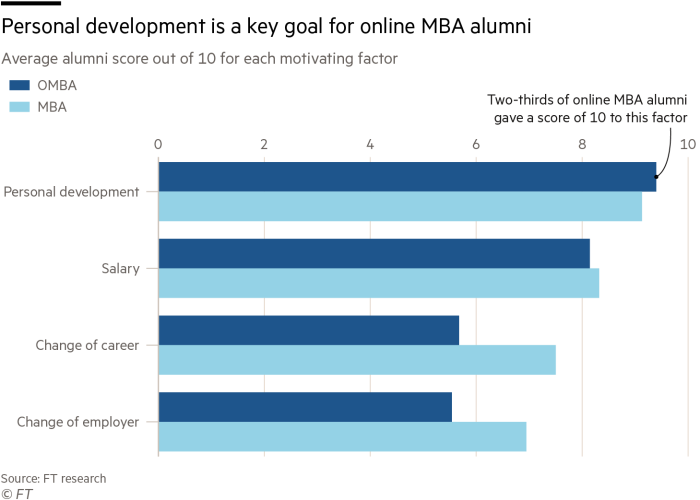
This finding may indicate alumni got what they wanted from their courses. Most say that means personal development followed by better earnings, which are also the main motivating factors for conventional MBA graduates. In other respects, though, motivations differ: a change of employer or of career is less important for online MBA alumni.
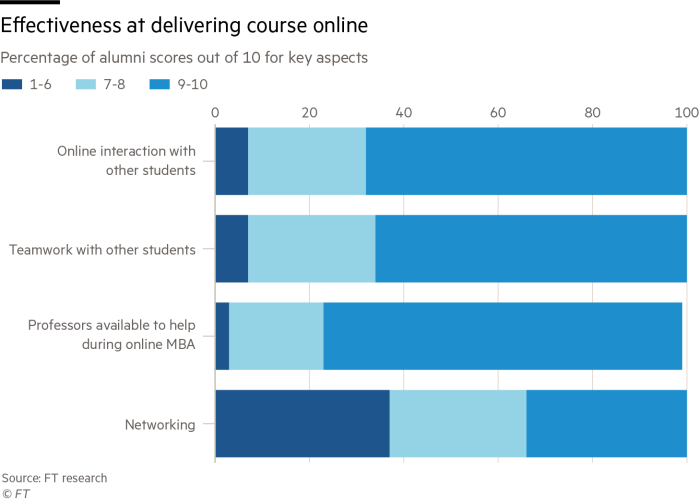
The data also show that schools are becoming better at encouraging online interaction among their students. The percentage of graduates who gave the highest possible score — 10 — for schools’ performance in this area rose from 40 per cent in 2018 to 51 per cent in 2022. Scores for teamwork and professors’ availability have also improved over the past few years. Networking, however, could be better.
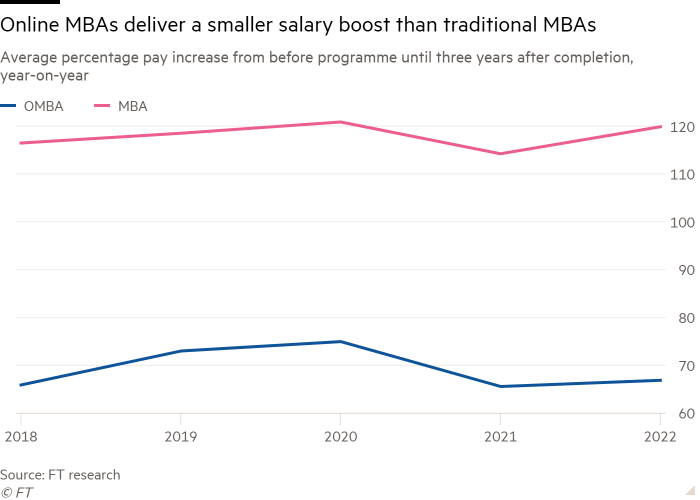
And so could salaries. While there are some differences in the way the percentage increase in salary is calculated in the FT rankings for online MBAs and for full-time MBAs, the data provide some interesting comparisons. The average percentage increase in online MBA graduates’ salaries is under 70 per cent — 49 percentage points lower than the average salary increase for global MBA graduates. The salary increase peaked in 2020 for both programmes.
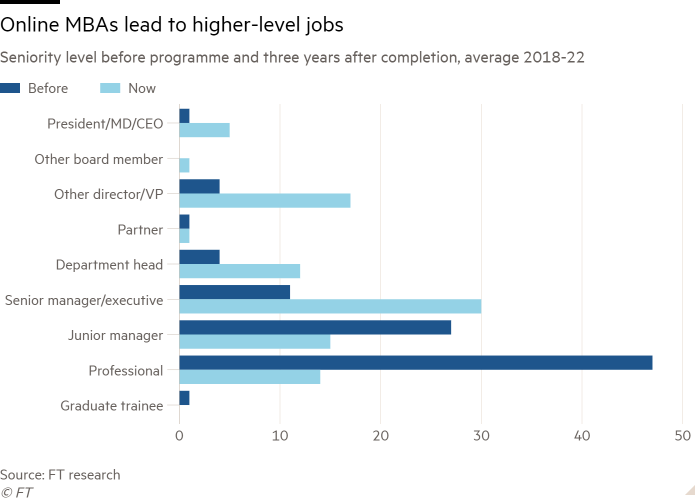
Graduates can also expect better career opportunities after completing their online MBA.
Nearly half of all graduates were at a “professional” seniority level when they started their programmes — the second lowest in the scale used. Three years after completion, the proportion dropped to 14 per cent, with the number of alumni in senior management and other executive roles increasing greatly.
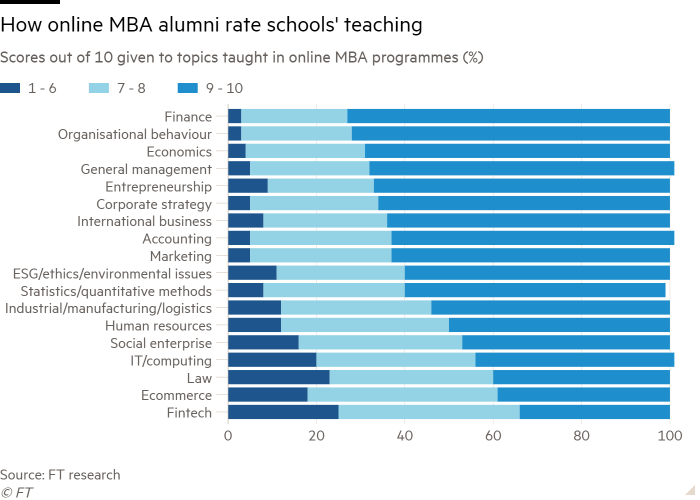
Finance and organisational behaviour are the teaching topics that have been consistently highly rated over the past five years by alumni of ranked schools. Fintech and ecommerce training consistently receive lower scores.
This year’s ranking is based on surveys of schools and of alumni who completed their online MBAs in 2018.
Additional reporting by Sam Stephens
Key to ranking table
• Weighting percentages are shown in brackets below.
• For the three gender-related criteria, schools that have 50:50 (male: female) composition receive the highest score.
Salary today US$ (20): average alumni salary three years after completion, $ PPP equivalent (see methodology).†
Salary increase (10): percentage increase in alumni salary in current job versus three years ago on completion.†
Value for money (3): calculated according to alumni salary, fees and other costs.†
Career progress (4): progression in alumni seniority and the size of company they now work for, versus three years ago on completion.†
Aims achieved (4): extent to which alumni fulfilled their goals for taking an online MBA.†
Careers service (4): effectiveness of school careers service for career counselling, personal development, networking events and recruitment, as rated by alumni.†
Programme delivery (5): how alumni rate the online delivery of live teaching sessions, other teaching materials and online exams.†
Online interaction (10): how alumni rate the interaction between students, teamwork, and availability of faculty.†
Female faculty (3): percentage of female members of faculty.
Female students (3): percentage of female students on MBA programme.
Women on board (1): percentage of female members on school advisory board.
International faculty (4): percentage of faculty whose citizenship differs from school’s location.
International students (4): percentage of current students whose citizenship differs from school’s location.
International board (2): percentage of board whose citizenship differs from school’s location.
International mobility (5): based on alumni citizenship and the countries where they worked before their MBA, on completion, and three years after.†
Faculty with doctorates (5): percentage of full-time faculty with a doctoral degree.
Environmental, social and governance rank (3): proportion of credits from school’s core courses dedicated to ESG issues.
FT research rank (10): calculated using Clarivate data covering 50 journals selected by the FT from the Web of Science, an abstract and citation database of research literature. The category combines the absolute number of article publications by current full-time faculty members between January 2019 and at least October 2021, with the number weighted relative to the faculty’s size.
Additional notes
The following data are for information only and are not used in the ranking calculations.
Course tuition and fees (local currency): Programme tuition and fees paid by the most recently enrolled class to complete the programme, in the currency of the country in which the school is situated. Figure shows weighted average.
Average completion time (years): The average amount of time students take to complete the programme.
Online teaching materials (%): Percentage of programme teaching materials that are delivered online.
Overall satisfaction: Average evaluation by alumni of the course, scored out of 10.
† Includes data for class of 2018 and one or two preceding classes if available.
Methodology: how the Financial Times Online MBA 2022 ranking was compiled
By Leo Cremonezi, Sam Stephens and Wai Kwen Chan
This is the ninth annual edition of the Financial Times ranking of the best online MBA programmes worldwide. A total of 29 schools took part in the 2022 edition.
All participating business schools must meet the FT’s strict entry criteria. The school must be accredited by AACSB or Equis and programmes must have run for four consecutive years. At least 70 per cent of the content must be delivered online. The participants must also pass a selection process before enrolling and an examination process before graduating.
Data were collected through two online surveys — the first was completed by participating schools and the second by their alumni who finished their Online MBA in 2018. Some 634 of them completed our questionnaire — a response rate of about 17 per cent.
The FT typically requires a response rate of 20 per cent of alumni, with a minimum of 20 responses, for a school to enter the ranking calculations. Due to the pandemic, the FT considered schools with a lower response rate.
The ranking has 18 criteria. Alumni responses inform nine criteria that together contribute 65 per cent of the total weight. Another eight criteria are based on the school data, accounting for 25 per cent. The remaining criterion, the research rank, counts for 10 per cent.
Alumni-informed criteria are based on data collected in the past three years. Responses from the 2022 survey carry 50 per cent of the total weight and those from 2021 and 2020 account for 25 per cent each. Excluding salary criteria, if only two years’ data are available, the weighting is split 60:40, if data are from 2022 and 2021, or 70:30, if data are from 2022 and 2020. For salary figures, the weighting is 50:50 for two years’ data.
The first two alumni criteria are average income three years after completion and the salary increase compared with their pay on completion, with respective weights of 20 per cent and 10 per cent. For the latter, half of the weight applies to the absolute increase and half to the percentage increase (the published figure). Salaries are converted to US dollars using IMF purchasing power parity rates for October 2021.
The salaries of non-profit and public sector workers and full-time students are removed, as are the highest and lowest salaries for each school, in order to calculate a normalised average. Finally, salaries are weighted to reflect differences between industry sectors.
“Value for money” for each school is calculated by dividing average alumni salary three years after graduation by the programme’s total cost, including tuition fees and other expenses. Any financial help given to alumni is subtracted from the total cost.
School criteria include the diversity of staff, board members and students by gender and nationality. For gender criteria, schools with a 50:50 composition score the highest.
The environmental, social and governance category is based on the proportion of credits from core courses dedicated to ESG issues. It carries a weight of three per cent.
The research rank is based on the number of articles by full-time faculty in 50 internationally recognised academic and practitioner journals. The rank combines the number of publications from January 2019 to at least October 2021, with the figure weighted relative to the size of the faculty.
The Online MBA ranking is a relative listing. Schools are ranked against each other by calculating a Z-score for each criterion. The Z-score is a statistic that shows where a score lies in relation to the mean. These scores are then weighted as outlined in the ranking key and added together for a final score.
After removing the schools that did not meet the response rate threshold from the alumni survey, a first version is calculated using all remaining schools. The school at the bottom is removed and a second version is calculated, and so on until the top 10 have been identified. The top 10 schools are ranked accordingly to produce the 2022 list.
Judith Pizer of Pizer-MacMillan acted as the FT’s database consultant
Criteria for taking part in our ranking
Updated on 7/12/2022 — NOTE:: We review the criteria on a regular basis. The pandemic has affected business schools and our ranking process, but we have done our best to accommodate feedback from schools. Please note, we are unable to include requests from every school.
The FT Online MBA ranking is based on two surveys: one for the business school and one sent to your alumni who have completed their Online MBA three years ago.
Please note, we only rank general MBAs — not specialised ones. Your Online MBA chosen for this ranking can be a full-time, part-time or flexible programme.
The following are the criteria schools must meet in order to participate in the annual ranking:
The business school must be accredited by AACSB or Equis.
The programme should have been running continuously for the past four years and should have graduated its first class in the calendar year three years prior to the survey date, or before.
At least 70 per cent of the programme content must be delivered online. The programme can be either synchronous or asynchronous.
The participants must pass a selection process before enrolling.
At least 30 students must have completed the programme, per year, three years ago and in each subsequent year.
The programme must deliver its degree following an examination process. Exams can be taken at any time during the course.
The business school must have a minimum of 20 full-time permanent faculty.
The MBA programme must be delivered in English. Graduates need to complete the survey in English.
Where applicable, the programme must be delivered by the same faculty that deliver the school’s campus-based MBA programme.
Ideally, business schools should be able to supply the email addresses of all its alumni who completed their programme three years ago. These will be used purely for editorial research purposes and held securely and destroyed after use, unless they agree for us to contact them again for future research, respecting GDPR and the FT rankings privacy policy: https://bschoolportal-ft-com.ezp-prod1.hul.harvard.edu/privacy-policy. Please exclude those who want to opt out of our survey. Please do not select and lobby alumni to complete the survey.
We need a response rate of at least 20 per cent from alumni with a minimum of 20 completed surveys from any school wishing to be considered for the ranking. E.g., a class size of 100 graduates will require 20 completed surveys and a class size of 200 alumni will require 40 completed surveys. This response rate is based on the total size of the cohort we are surveying, not the number graduate emails you will be able to supply, as we are aware that some alumni will opt out of the survey.
Meeting these criteria does not guarantee automatic participation in the ranking. The final decision rests with the Financial Times.
Please note, the table is finalised about five weeks before the publication date. It is too late for schools to withdraw from the ranking after the five-week mark.
Email online.mba@ft.com by the start of October if you have questions or wish to take part as the ranking process starts in late October or early November. By this time, the onus is on schools to get in contact with us if they wish to take part in the ranking, as we are unable to email every single school to check if they wish to be considered.
Report: https://www-ft-com.ezp-prod1.hul.harvard.edu/online-learning
Rankings: https://rankings-ft-com.ezp-prod1.hul.harvard.edu
Methodology: https://www-ft-com.ezp-prod1.hul.harvard.edu/online-mba-method
Timings
Invitation to participate: November
Schools to confirm participation: November
Schools to upload alumni list: December
Schools to upload faculty list: January
Survey open: December/January
Survey close: February
Data checks with schools: February to March
Publication: March
Comments